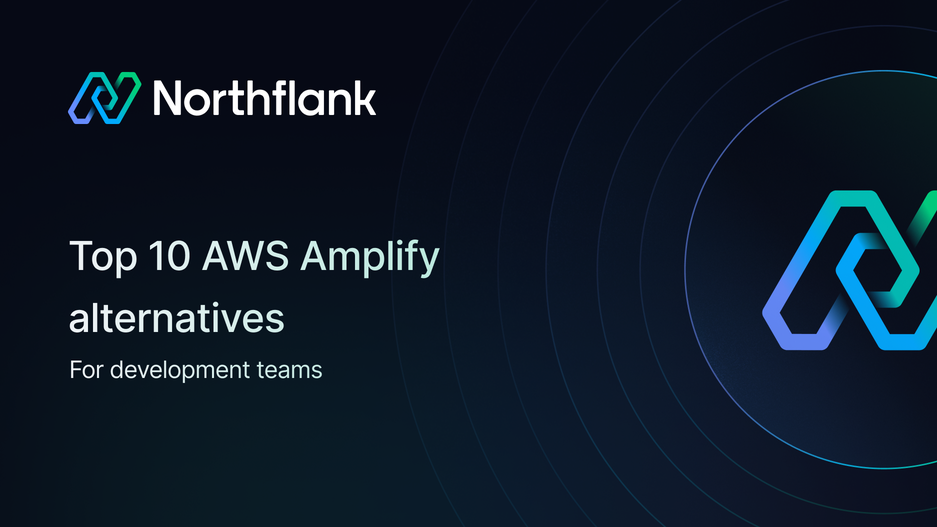

Top 10 AWS Amplify alternatives for development teams in 2025
AWS Amplify works well for AWS-centric teams but lacks multi-cloud flexibility and can get expensive at scale. Here are the top alternatives:
- Northflank - Production-grade platform supporting deployment to Northflank's managed cloud or your own AWS/GCP/Azure accounts. Handles everything from full-stack apps to AI workloads with built-in observability, backups, and compliance features. Best for teams needing enterprise capabilities with infrastructure flexibility.
- Firebase/Supabase - Mobile-first BaaS with real-time databases. Firebase for Google Cloud integration, Supabase for open-source PostgreSQL-based alternative with self-hosting option.
- Vercel/Netlify - Frontend-optimized platforms. Vercel dominates Next.js deployment, Netlify offers broader framework support with extensive build plugins. Limited backend capabilities.
- Render - Heroku alternative with managed databases, background workers, and straightforward pricing. Good for traditional full-stack apps without serverless complexity.
- Railway - Simple deployment with transparent usage-based billing. Best for side projects and small teams wanting minimal configuration.
- Fly.io - Global edge deployment with low-latency access. Deploy Docker containers close to users worldwide. Requires more infrastructure knowledge.
AWS Amplify is Amazon's full-stack development platform designed to help frontend developers build web and mobile applications quickly.
It combines backend-as-a-service capabilities with Git-based frontend hosting, offering authentication, GraphQL APIs, storage, serverless functions, and CI/CD workflows in a unified package.
Amplify speeds up initial development through its TypeScript-first approach and visual Studio tool, making it well-suited for teams building React, Next.js, Vue, or mobile applications needing fast prototyping with AWS services
When comparing platforms, keep these factors in mind:
- Deployment model - Does your team need managed cloud, bring-your-own-cloud capability, or hybrid deployment options?
- Backend capabilities - Evaluate authentication, database support, API management, file storage, and serverless function offerings against your requirements.
- Pricing structure - Compare usage-based versus predictable pricing, considering your traffic patterns and growth projections.
- Developer experience - Assess Git integration quality, preview environments, deployment speed, and how well the platform fits your team's workflow.
- Scaling and performance - Review autoscaling capabilities, global distribution options, and performance optimization features.
- Team collaboration - Consider access control, environment management, and how well the platform supports your team size and structure.
Now that you know what to look out for, let's see how each platform compares across these criteria.
Northflank provides a comprehensive developer platform designed for teams that need both simplicity and production-grade capabilities. Unlike traditional PaaS solutions, Northflank offers enterprise features without sacrificing developer experience.
What sets Northflank apart:
- Bring Your Own Cloud (BYOC) - Deploy to your AWS, GCP, Azure, Civo, or Oracle accounts while enjoying Northflank's managed platform layer. Maintain control over data residency, compliance, and cloud costs without infrastructure overhead.
- Full-stack deployment support - Handle everything from microservices and APIs to databases, background workers, cron jobs, and GPU-powered AI workloads from a unified interface.
- Production-ready by default - Built-in observability, automated backups, health checks, rollbacks, and disaster recovery eliminate the need to piece together external tools.
- Real-time collaboration - Live interface updates, granular RBAC permissions, team roles, and SSO integration support enterprise security requirements.
- No infrastructure YAML - Deploy complex workflows through an intuitive UI, REST API, or CLI without writing Kubernetes configurations.
Best for: Teams building production applications that need enterprise compliance, multi-cloud flexibility, or want to avoid platform vendor lock-in while maintaining a seamless developer experience. Especially valuable for organizations requiring HIPAA, SOC 2, or ISO 27001 compliance.
Northflank pricing:
- Developer Sandbox: Free tier with generous limits for testing and small projects
- Pay as you go: Starting at $0/month with infrastructure usage billing, unlimited projects and collaborators
- Enterprise: Pricing based on features and deploy footprint
See full pricing details or book a demo to speak with an engineer or try out the platform via the free developer sandbox
Migration path from Amplify: Northflank's Docker-based deployment accepts any containerized application. Teams can gradually migrate services while maintaining existing AWS resources, then optionally consolidate to Northflank's BYOC model for cost optimization.
Firebase provides Google's comprehensive backend-as-a-service solution with extensive mobile SDK support and real-time database capabilities.
Key features:
- Firestore NoSQL database with real-time synchronization
- Firebase Authentication with social provider integration
- Cloud Functions for serverless backend logic
- Cloud Storage for file uploads
- Hosting with global CDN via Google Cloud
- Built-in analytics and crash reporting
- Machine learning kit for mobile AI features
Best for: Mobile-first applications, real-time collaborative apps, prototypes needing rapid development, and teams already invested in Google Cloud ecosystem.
Vercel specializes in frontend deployment with support for React, Next.js, and modern JavaScript frameworks.
Key features:
- Zero-config Next.js deployment with ISR and SSR support
- Automatic preview deployments for every pull request
- Global edge network for fast content delivery
- Built-in analytics and performance monitoring
- Serverless functions for API routes
- Integration with headless CMS platforms
Best for: Frontend-focused teams building with Next.js, React, Vue, or Svelte. Ideal for marketing sites, e-commerce frontends, and documentation platforms prioritizing speed and developer experience.
Netlify pioneered the JAMstack approach with Git-based deployments and serverless architecture for static sites and SPAs.
Key features:
- Continuous deployment from Git repositories
- Built-in form handling and identity management
- Serverless functions via Netlify Functions
- Split testing and feature flags
- Large plugin ecosystem for build customization
- Edge functions for dynamic content at the edge
Best for: Static sites, SPAs, JAMstack applications, and teams wanting extensive build plugins. Strong choice for content-driven sites built with Gatsby, Hugo, or Eleventy.
Render provides a developer-friendly platform emphasizing simplicity while offering more flexibility than traditional PaaS solutions.
Key features:
- Support for web services, background workers, and cron jobs
- Managed PostgreSQL, Redis, and other databases
- Automatic SSL and custom domain support
- Private networking between services
- Git-based deployments with preview environments
- Docker and native buildpack support
Best for: Full-stack web applications, APIs with persistent databases, teams migrating from Heroku, and projects needing background job processing.
Railway focuses on making deployment accessible while providing powerful features for growing applications.
Key features:
- One-click deployment for popular frameworks
- Built-in PostgreSQL, MySQL, MongoDB, and Redis
- Automatic preview environments from pull requests
- Simple usage-based billing model
- Template marketplace for common stacks
- Straightforward interface minimizing configuration
Best for: Side projects, startups, and small to medium teams wanting simple deployment without complex billing. Good for developers new to cloud deployment.
Supabase provides an open-source backend-as-a-service built on PostgreSQL, offering more flexibility than proprietary alternatives.
Key features:
- PostgreSQL database with real-time subscriptions
- Built-in authentication with multiple providers
- Instant REST and GraphQL APIs from database schema
- File storage with image transformations
- Edge Functions using Deno runtime
- Self-hosting option for full control
Best for: Teams wanting open-source solutions, PostgreSQL enthusiasts, applications requiring relational database features, and organizations needing self-hosting capability.
Azure Static Web Apps combines static site hosting with serverless API capabilities within the Azure ecosystem.
Key features:
- Automatic deployment from GitHub and Azure DevOps
- Integrated Azure Functions for API backend
- Global distribution via Azure CDN
- Custom domain and free SSL certificates
- Authentication integration with Azure AD
- Tight integration with Azure services
Best for: Organizations already using Azure, teams requiring Microsoft ecosystem integration, and enterprises with Azure Enterprise Agreements.
Despite recent challenges including pricing changes and outages, Heroku remains a popular choice for its simplicity and extensive add-on marketplace.
Key features:
- Simple Git-based deployment workflow
- Extensive add-on ecosystem (over 200 services)
- Support for multiple programming languages
- Automatic scaling with dyno management
- Review apps for pull request testing
- Pipeline workflow for deployment stages
Best for: Teams prioritizing deployment simplicity, applications benefiting from the add-on ecosystem, and prototypes requiring rapid iteration.
Fly.io enables running applications close to users worldwide through edge computing capabilities.
Key features:
- Deploy applications to data centers near users
- Low-latency access through geographic distribution
- Docker-native deployment model
- Private networking between regions
- Persistent volumes for stateful applications
- Flexible VM configurations
Best for: Globally distributed applications, real-time services requiring low latency, gaming backends, and applications with international user bases.
Selecting an Amplify alternative depends on your specific requirements, team expertise, and long-term goals. Consider these scenarios:
| Platform | Best For |
|---|---|
| Northflank | Full-stack deployment with production-grade observability, Bring Your Own Cloud (BYOC) capability while maintaining platform benefits, Support for complex architectures including microservices, databases, and AI workloads, Team collaboration features with granular access control |
| Firebase or Supabase | Mobile-first development with SDKs, Real-time database synchronization, Rapid prototyping with comprehensive backend services, Authentication and storage without infrastructure management |
| Vercel or Netlify | Frontend-focused deployment, Minimal backend requirements, Framework-specific optimizations |
| Render or Railway | Traditional service-based architecture, Background workers and cron jobs, Straightforward pricing models, Heroku-like simplicity with better value |
| Fly.io | Global edge deployment, Low-latency international access, Full control over geographic distribution |
AWS Amplify works well for AWS-centric teams, but as applications mature and requirements change, many need different capabilities around pricing predictability, infrastructure control, or multi-cloud support.
The alternatives in this guide each specialize in specific areas: Northflank for enterprise-grade features with Bring Your Own Cloud (BYOC) flexibility, Firebase and Supabase for mobile and real-time applications, Vercel and Netlify for frontend deployment, and Render and Railway for balanced full-stack solutions.
Want a platform that combines PaaS simplicity with enterprise-grade capabilities? Try Northflank's free Developer Sandbox.